From a speech by Tim Newell
Tim Newell worked for the Prison Service in England for 37 years. He recently retired after ten years as the governor of Grendon and Spring Hill prisons. As governor, he avoided the often punitive and stigmatizing practices of typical prisons. Instead, he created a therapeutic community environment that incorporated principles of restorative practices. The following is from his plenary speech at the IIRP’s Third International Conference in August 2002. In this speech he discussed his experience building these model prison communities, prison culture and how restorative practitioners can overcome institutional resistance.
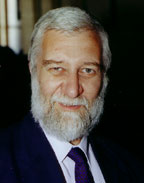 |
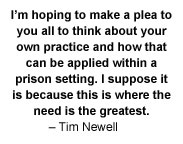 |
My first experience with restorative work was actually as a victim. I was living onsite of a young offender establishment. I had been in the job a couple of years and my bachelor home was burglarized by one of the offenders. We were able to quickly establish who it was. In discussing with Barry why he had done it, he said that he was quite interested in getting into a home setting and was interested particularly in my home. Being a bachelor and being at the start of a job, my home was rather sparse. He was unfortunately not well rewarded by the experience. Most young offender establishments have a culture that puts quite an emphasis on personal cleanliness and tidiness. One of the interesting things in the dialogue with Barry was some fairly strong advice he gave me on how to tidy my place up.
I celebrate the work that is taking place at present within prisons. They are demanding places to work in and are very challenging environments in which to introduce some of the ideas we’ve been hearing about at this conference. Over the years, one of the questions I would regularly be asked was, “Why aren’t there more Grendons?” It really is a unique environment where the culture is very different from other prisons. The predominance of fear that dominates most prison settings was by-and-large removed over a period of time through the involvement of and the trust that developed between some very heavy offenders. Half of the 250 prisoners are life sentence prisoners, murderers, rapists and serious offenders. How is it that this culture is not spread to other prisons?
Sadly, prisons are often lacking in hope for the future. If I were a prisoner, I would not be too optimistic about my chances, given the reconviction rates we are dealing with. For young offenders in England, we’re looking at a return to court at 85 to 90 percent within two years of being released. For adults, we are looking at 55 to 60 percent returning to court and a conviction within two years of release. It’s currently something like £35,000 in England to keep someone in for a year. It’s extremely expensive. We now have over 72,000 people, which goes up every week and every month.
Given that the values of restorative work are in conflict with the experience of imprisonment, why do we work in prisons? Why am I asking that we try to focus our work much more in that area? I’m hoping to make a plea to you all to think about your own practice and how that can be applied within a prison setting. I suppose it is because this is where the need is and where the need is the greatest.
The picture that is often presented to me is that it is hard working in prisons. There are the restorative champions who have a lot of information and a lot of skills that they are bringing with them. They work hard to try to move people and ideas. There are often many observers just watching to see what will happen and quite often it feels as though there are a lot of people who are obstructing. This resistance is not personal. It is a dynamic. It’s a dynamic that comes from within the organization. We’ll look at ways in which, perhaps, it is possible to get through some of this obstruction.
I will try to answer a question that was put to me recently. I was at a conference looking at the work of the Thames Valley Police. The assistant chief constable was sitting next to me and handed me a card which read, “Why is it so hard to move the mainstream of the criminal justice system from doing things we know don’t work to doing things we know do?” I expect that’s a question many of us have been asked over the years. He asked me to email him an answer. I’m still working on it. I started doing something about it.
Let’s look at prison culture and values. Obviously, the security role is predominant within most prison cultures. Also, there is a strong subculture of prisoner secrecy and distance from staff. In order to survive, there is secrecy and subculture development. The prison culture is dominated by risk avoidance because sometimes the risks are considered to be far too high. The political pressure is on to try to avoid taking too many risks and avoid making too many mistakes. There is a very hierarchical structure within the prison setting.
In contrast, Grendon had a very clear prime objective. Therapy was its purpose. Men came there to seek to understand themselves and resolve aspects of their past behavior in exploring their current behavior. The treatment ethic was dominant. Everybody was involved in it, including prison officers, people who worked in the administrative departments and myself as governor. I was accountable. I’ve had several interesting sessions in which I was called down to community meetings to explain decisions that I’ve made and give an account as to why things happened in a certain way. The considerable social distance between staff and prisoners was very greatly reduced in order to actually carry out this work.
People were seen very much as equals within the setting. All staff and all prisoners were regarded as therapists. In a therapeutic community, that’s the role everybody takes on. You don’t have experts. You don’t have individual work. You work very much as a community. Whenever there was an issue or a problem, the mantra was, “Take it to your group.” You don’t resolve it in private. You resolve it in public. The ethos of the management was to actually manage risk because the treatment was dependent upon allowing people to make mistakes and establish wider boundaries for their own behavior.
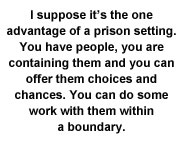 The staff structure was extremely flat. We tried to ensure that as many decisions as possible were made within the communities where the staff was working directly with prisoners. So there were very few decision-making committees within the establishment. One of the key things was that the process was important. Everything that was done was done within an inclusive process so everybody was involved. There was an openness about decisions even when pretty horrible decisions had to be made, such as people being moved on or programs being shut down for lack of finance.
The staff structure was extremely flat. We tried to ensure that as many decisions as possible were made within the communities where the staff was working directly with prisoners. So there were very few decision-making committees within the establishment. One of the key things was that the process was important. Everything that was done was done within an inclusive process so everybody was involved. There was an openness about decisions even when pretty horrible decisions had to be made, such as people being moved on or programs being shut down for lack of finance.
Within that environment, Grendon was able to work. This is in contrast to other prisons. We were able to maintain the work because it was effective. We certainly had the lowest escape rate in England. We had the lowest assault rate of all prisons. Also, we had the highest involvement of prisoners in programs: 100 percent in Grendon. The staff were committed to the regime and practice, so there were no industrial relations issues at all in that environment. All prisoners looked after each other in terms of suicide prevention, so we were able to survive that as well. There was a long waiting list of prisoners wanting to come to the place. We had twice as many people on our waiting list as places in the prison. The reputation spread amongst prisoners that this was the place where they could actually achieve some understanding of themselves and perhaps some capacity to move on and not cause further damage.
Obviously, victims of those people who are in prison are often those most seriously affected by crime. The offenders have been the most damaging people. From my experience working with some of the most damaging people, they are also the most damaged people. Part of what needs to happen in prison is that personal experience of damage should be explored within that setting. I suppose it’s the one advantage of a prison setting. You have people, you are containing them and you can offer them choices and chances. You can do some work with them within a boundary. That’s one of the real advantages.
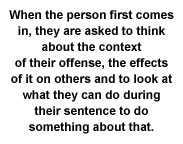 The communities of those people who are in prison are often the most relieved that the person is now behind the wall. But they are often the most anxious about what’s going to happen when this person returns and how that person is likely to behave. The context in which the offense occurred and the effects of the offense are very rarely considered within the prison setting. Before I retired, I was fortunate to have a short period doing some work in three other prisons. We worked with a group of staff within those prisons to look at the functions with which you could use restorative processes. In Winchester, Bristol and Norwich prisons we are working with the whole approach towards sentence management and sentence planning. So when the person first comes in, they are asked to think about the context of their offense, the effects of it on others and to look at what they can do during their sentence to do something about that.
The communities of those people who are in prison are often the most relieved that the person is now behind the wall. But they are often the most anxious about what’s going to happen when this person returns and how that person is likely to behave. The context in which the offense occurred and the effects of the offense are very rarely considered within the prison setting. Before I retired, I was fortunate to have a short period doing some work in three other prisons. We worked with a group of staff within those prisons to look at the functions with which you could use restorative processes. In Winchester, Bristol and Norwich prisons we are working with the whole approach towards sentence management and sentence planning. So when the person first comes in, they are asked to think about the context of their offense, the effects of it on others and to look at what they can do during their sentence to do something about that.
We are working with the anti-bullying policy and the race relations policy. We are working with the adjudications or infractions policy. Instead of going through a formal adjudication process where the warden is the judge and jury and gives the sentence, we suspend all of that and have a circle to determine what should happen as a result of an assault or other anti-social behavior within a prison context. Those are some of the things that are happening within those three prisons now.
There is a major project taking place in England and Wales at present, in the Thames Valley. It is a big research project based in a metropolitan area. It involves about five big prisons, particularly in the Thames Valley, which includes a prison named Bullingdon. There are formal conferences taking place with serious, violent adult offenders. The Home Office has funded it.
There was some concern that the work within Bullingdon prison was taking place without any incentive at all. Prisoners do not get parole or shorter sentences, just offered the opportunity [to participate in a conference]. Out of the 150 or so who fell into this category, about 130 have taken up the offer of doing it. They have now had over 50 conferences in the prison within the last nine months or so, which is really a roller coaster approach, I’m afraid. It’s going very fast. There has been a lot of staff trained to do it, including prison guards facilitating conferences. The effect upon the culture at Bullingdon is something we are looking forward to examining.
In a place called Brinsford, a young offender establishment, there is some very imaginative mediation work taking place between victims in the community and young offenders within the establishment. This includes face-to-face meetings, but more often includes reports, letters or videotapes that are sent in order to try and help both parties understand what happened.
The other aspect is the application of restorative principles to the whole prison. I suppose a place like Grendon would be seen as a totally different cultural approach where the whole prison is accountable and tries to work to a different set of values. We established a core team of prison officers and other staff, a multidisciplinary team. We did some awareness training for all prison staff. We did an audit of all the processes, which produced an action plan that we then prioritized. We have some allies now on the restorative side who are pushing a bit. The obstructers are getting a bit weaker and the observers are jumping off the fence. Since last year, another prison has opened with the same principles. It is called Dovegate. There are other people doing this sort of work, individually motivated, who have to carve out space, protocols and safety to carry out their practice. They have an uphill struggle every time they seek to make this sort of intervention.
The big challenge that is coming up is how do we seek to use this approach with the Headquarters and how do we try to help politicians and mandarins to work in a restorative way. There are some openings coming up. The Home Office is very concerned and is trying to reduce victim dissatisfaction. There are no strategies yet as to how that is going to be done, but one of the key things already coming out of the research from Bullingdon and the Thames Valley is how strongly victims feel committed to the process and how much they have gained from it.
Why is it so hard? The resistance is not a personal thing. I think it’s an organizational thing, it’s a dynamic thing and it’s a cultural thing. Because of the very unusual nature of the work, prisons have evolved a culture, a paradigm and a mindset that determines the way they do the things they have to do. This is a brief look at a model that is more fully described in my paper “Restorative Practice in Prisons: Circles and Conferencing in the Custodial Setting.” (To read this paper go to: www.iirp.edu/article_detail.php?article_id=NDQ1.)
What I would suggest is that we look at using the model to think about the six factors that focus on the paradigm in any organization you’re working in [see below]. I don’t think it just relates to prisons. I think every organization has this cultural web and the structure that supports it. Most consultants go for the easy ones—control systems, power structures and organizational structures—because they are more readily accessible. The important thing for us, I think, is to focus on the subconscious areas: the stories, symbols and rituals. Through that, one can assess the nature of the paradigm and look to develop our own stories, of which we have a massive amount. Our stories, our symbols and our rituals can help the organization meet its needs.
Obviously, stories are vitally important in any culture. What we say to each other and others about how we celebrate or denigrate what happens can determine how we feel about the place. The symbols we have, such as name badges, are important. The simple things that we use within prison settings. The symbolic use of names is vitally important. The director general saw that in private prisons in England, staff refers to prisoners as Mr., Miss or Mrs. So-and-so. Whereas in the public sector prisons, they are always referred to purely by their second or surname. He asked us all to think about how we could change that. The resistance to that has been tremendous and so deeply emotional that it obviously represents a serious symbol that will be difficult to shift.
Rituals and routines are vitally important as well within the subconscious of the culture. What rites of passage are there within the organization: rites of celebration, rites of degradation, rites of challenge and rites of counterchallenge? Paradigms are in the middle of this, which is what is being protected.
 I hope I’ve provided some ideas on how we can get through this resistance and how we can work to change the current state of prisons and our dependency upon them. What I would like to close with is to ask that you consider within your own practice the possibility of moving some of that into a prison setting: either to help people towards their release or to involve yourself during their time in the prison. I see this as the most serious arena for our work. It’s life and death matters that we are considering within prisons.
I hope I’ve provided some ideas on how we can get through this resistance and how we can work to change the current state of prisons and our dependency upon them. What I would like to close with is to ask that you consider within your own practice the possibility of moving some of that into a prison setting: either to help people towards their release or to involve yourself during their time in the prison. I see this as the most serious arena for our work. It’s life and death matters that we are considering within prisons.
I would like to end with some silence. But before the silence I would like to quote something that epitomizes how serious the need for restorative practice is in our society. This is from an English novelist, Ian McEwan, who wrote in The Guardian on the 13th of September last year [2001].
“If the hijackers had been able to imagine themselves into the thoughts and feelings of the passengers, they would have been unable to proceed. It is hard to be cruel once you permit yourself to enter the mind of your victim. Imagining what it is like to be someone other than yourself is at the core of our humanity. It is the essence of compassion and it is the beginning of morality.”
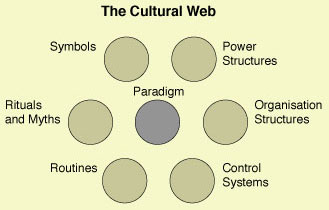 Excerpted from “Restorative Practice in Prisons: Circles and Conferencing in the Custodial Setting” by Tim Newell. In considering the application of restorative ideas in prisons, we could use the model of the cultural web. Through this we could audit the way in which changes are already taking place in some prisons and how more could be achieved through this methodical approach towards cultural change. Restorative practitioners are beginning to work more in prisons and this effort could be considered through the model of the cultural web so that the work is effective within the context of the project but also in affecting the wider prison community. The way that some of this work has been approached has influenced the functional areas of work described below. This work has been achieved by prison staff being dissatisfied with traditional ways of operating and realising that through restorative practice a more satisfactory process could be developed with more just outcomes. Through audit and developing practice it is possible to see there are opportunities in the following areas of functional activity in prisons: Induction programmes for prisoners. Establishing norms through staff and peer tuition and example, through setting standards and developing expectations of taking responsibility during the sentence can be very effective at the start of the sentence when prisoners are often at their most sensitive and receptive. Complaints and requests systems. The requests and complaints of prisoners can be considered through an open process of mediation and direct communication in order to establish what happened, who was affected, in what way and what should be done to put things right. This can be in contrast to some current practice that is often secretive in process and unsatisfactory in outcome for all parties. Adjudications. Disciplinary hearings form a critical focus of many prison systems. How infractions of the rules are considered by the prison sets the tone of staff attitudes and prisoner compliance in many prisons. To offer an alternative process of a circle is a dramatic way to express the concept of staff and prisoners working together to resolve conflicts rather than reacting to them stereotypically. This process can be seen to gain a win-win setting, rather than the inevitable win-lose one of blame and scapegoating. (Continued on next page.) Race relations. Similar handling of equal opportunity issues through open ways of mutual respect can establish for staff and prisoners that such matters are taken seriously. Their concerns will be handled fairly and openly whenever possible, recognising the perceived victim’s feelings and willingness for such a process. Anti-violence strategy. The same considerations apply as for the anti-bullying strategy. The strategy to be developed could well include training for staff and prisoners in conflict-resolution awareness and skills, perhaps through a programme like the AVP (Alternatives to Violence Project). The establishing of peer mediators, as with the ‘listeners’ programme for suicide prevention and the peer education-tutoring scheme, will play to the strengths of many prisoners in managing difficult settings and in being able to support each other. Preparation for release. When sentence planning is done in partnership with prisoners many restorative justice possibilities arise for accepting responsibility for the crime, establishing some accountability for the future to victims, primary and secondary, and a commitment to the community to which prisoners will return. The resources of the prison—work, education, leisure, offending behaviour courses and other programmes—can be channeled to this effect. Victim empathy and accountability for criminal behaviour are expressed in these programmes in which prisoners take responsibility for their behaviour. This is the ideal setting for voluntary compliance, honesty and contrition to be expressed. Resettlement. Preparation for resettlement should start early in the sentence and should engage the agencies that are likely to be affected by the prisoner’s release, such as housing, health and employment, as well as the criminal justice agencies of police and probation. On home leave or temporary release from prison, offer the possibility of a conferencing of agencies, including justice ones, with the prison providing some feedback about the course of the sentence and about future expectations. Family and victims could be involved in this process that is focused on the issues of returning to the community. Circles on release. Once released, the prisoner often experiences difficulties in sustaining the plans and the intentions when in custody. There is sometimes a need to provide some community support and involvement through a formal Circle of Support and Accountability. Prison Outreach. Staff and prisoners can serve the community by educating groups about the effect of imprisonment through the sharing of information about prisons and about the life stories of offenders. Staffing processes. In order to integrate restorative justice practices, principles and processes into the prison’s life it is important that prison staff feel that they are treated with the same respect and consideration. Thus, dispute and conflict resolution procedures should be developed offering mediation and conferencing for staff with trained facilitators. The personnel management of staff should operate with the same principles of concern for the individual and the respect for their personal development within the professional setting. |
